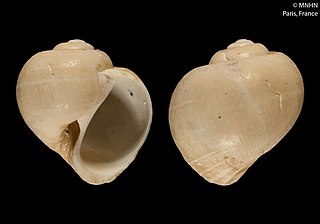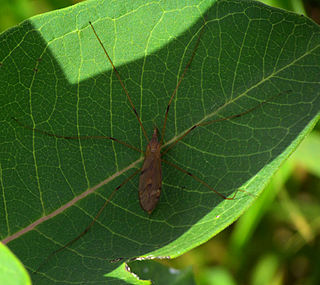
Falsilunatia is a genus of sea snails, marine gastropod molluscs in the subfamily Globisininae of the family Naticidae, which are known as moon snails or moon shells.
Neocladura is a genus of crane fly in the family Limoniidae.
Nothoadmete delicatula is a species of sea snail, a marine gastropod mollusk in the family Cancellariidae, the nutmeg snails.
Latiromitra delicatula is a species of sea snail, a marine gastropod mollusk in the family Ptychatractidae.
Kerguelenatica delicatula is a species of predatory sea snail, a marine gastropod mollusk in the family Naticidae, the moon snails.

Rostellariella delicatula, common name the delicate tibia, is a species of sea snail, a marine gastropod mollusk in the family Rostellariidae, the true conchs.
Rostellaria is a genus of sea snails, marine gastropod mollusks in the family Strombidae, the true conchs.

The spotted lanternfly is a planthopper that is indigenous to parts of Southern China, Taiwan, and Vietnam, and has spread invasively to Japan, South Korea, and the United States. Although it has two pairs of wings, it jumps more than it flies. Its host plants include grapes, stone fruits, and Malus species, although its preferred host is Ailanthus altissima. In its native habitat it is kept in check by natural predators or pathogens. It was accidentally introduced in South Korea in 2006 and has since been considered a pest. In September 2014, it was first recorded in the United States, and as of 2020 it is an invasive species in the Delaware Valley, northern Delaware, eastern Maryland, eastern Pennsylvania, southwestern New Jersey, New York, Connecticut, northern Virginia, and Ohio.
Apitua delicatula is a species of sea snail, a marine gastropod mollusk in the family Mangeliidae.

Lycorma is a genus of insects in the family Fulgoridae: subfamily Aphaeninae; species are found in Asia. L. delicatula, known as the Spotted lanternfly, is an invasive species.

Eriopterini is a tribe of limoniid crane flies in the family Limoniidae. There are more than 20 genera and 3,800 described species in Eriopterini.
Psoloessa is a genus of slant-faced grasshoppers in the family Acrididae. There are at least four described species in Psoloessa.

Cariblatta is a genus of cockroach in the family Ectobiidae. There are more than 70 described species in Cariblatta.
Anaxipha delicatula, the chirping trig, is a species of winged bush crickets, trigs in the family Trigonidiidae. It is found in North America.

Hemerotrecha is a genus of windscorpions in the family Eremobatidae. There are more than 30 described species in Hemerotrecha.
Psoloessa delicatula, the brown-spotted range grasshopper, is a species of slant-faced grasshopper in the family Acrididae. It is found in North America.
Podmosta is a genus of spring stoneflies in the family Nemouridae. There are about six described species in Podmosta.
Cymatodera delicatula is a species of checkered beetle in the family Cleridae. It is found in Central America and North America.
Myrciaria delicatula, commonly known as cambuí uvaia doce, cambuí graudo, cambuim, or cambu branco, is a species of plant in the family Myrtaceae.
Guinardia is a genus of diatoms belonging to the family Rhizosoleniaceae.





